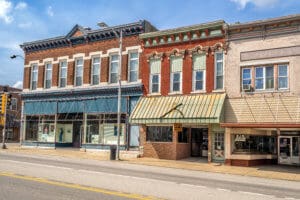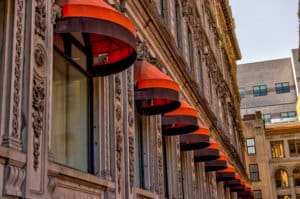Owning a historic home or commercial business comes with responsibility. Historic properties connect to a community’s culture and are valued by many other people than just those who have a financial investment in it. Some structures have been given an official designation of “historic,” which comes with specific rules and limitations regarding property improvements and restorations. Other times, building owners simply desire to preserve the original look and feel of a home or business to honor the structure’s history or blend well with other structures in the area. A professional awning partner like Deluxe Awning Company is experienced with selecting and installing awnings on historic buildings.
 Historic buildings often feature door and window awnings. Depending on when the structure was built, the original awnings may have been wood, metal, or canvas. Wood and metal awnings that have survived require regular care and maintenance. Canvas awnings usually last 10 to 15 years, so the original cloth will have deteriorated many decades ago, but the original metal framework may still be functional. In other situations, photographs of the building may show awnings, but owners over the years may have removed them for one reason or another. Regardless of the situation, Deluxe Awning Company can help you return the appearance of your structure to its original look and feel.
Historic buildings often feature door and window awnings. Depending on when the structure was built, the original awnings may have been wood, metal, or canvas. Wood and metal awnings that have survived require regular care and maintenance. Canvas awnings usually last 10 to 15 years, so the original cloth will have deteriorated many decades ago, but the original metal framework may still be functional. In other situations, photographs of the building may show awnings, but owners over the years may have removed them for one reason or another. Regardless of the situation, Deluxe Awning Company can help you return the appearance of your structure to its original look and feel.
5 Tips for Selecting and Installing Awnings on Historic Buildings:
Our staff at Deluxe Awning Company will visit your location to work with you to select the best size, style, and shape of awning for your home or business. However, here are a few general tips to get you thinking about selecting and installing awnings on historic buildings.
- Look for a traditional design. Review historical pictures of the neighborhood and note some of the common features of traditional awning designs. For example, a basic shed-style awning was often installed over rectangular doors or windows, while an arched design was used to match the shape of rounded, arched openings. It’s also possible to find modern, durable materials that will provide the look of a traditional metal awning without the weight or maintenance this type of feature requires.

Example of a rounded awning for arched windows. 
Example of a shed-style awning over a rectangular opening. - Choose a color and style to complement your historic structure. Historically, most awnings were either solid or striped and featured conservative colors. For example, in history, crimson, true red, navy, forest green, and butter yellow were all popular colors for awnings.
- Avoid covering architectural details. Historic buildings were often constructed with beautiful and unique architectural features. Your awnings should complement columns, window frames, or other decorative elements–not cover them. A professional awning consultant will help assess your location and determine the best size and shape to give you adequate coverage while allowing other features to be visible.
- Obtain required approvals. You may be required to apply with your city’s development division for approval before altering features on your historic home or business. Be sure to review any restrictions or limitations that apply specifically to your location or your neighborhood as a whole.
- Hire a qualified installer. It’s critical for you to preserve the integrity of your structure. Poor construction and installation of an awning can crack, break, or otherwise damage brick, woodwork, and cement. Choose a qualified professional like Deluxe Awning Company to ensure your historic building will be preserved well.
Deluxe Awning Company is your professional construction partner.
We’re proud to be a local business serving our community since 1982. Over the years, Deluxe Awning Company has grown to become an area leader in home and commercial awnings. We believe in personalized service and putting our customers first. No matter how large or small your project is, you can rest assured you’ll receive full attention from our professional team. Contact us today to see how easy it is to get started.



Leave a Reply